Techniques for Ethnographic Conversations and Interviews
 The techniques described below are based largely on James P. Spradley’s The Ethnographic Interview. This type of interviewing is particularly “kind” to interviewees, respects their rights, and attempts to see the world as they see it.
The techniques described below are based largely on James P. Spradley’s The Ethnographic Interview. This type of interviewing is particularly “kind” to interviewees, respects their rights, and attempts to see the world as they see it.
Some General Assumptions
The aim of the interview is to get the informant to respond as fully and as freely as possible. Let them do the talking so that you can learn from them, through their language, about their concepts and experiences. This means:
- Starting from ignorance i.e. not going in with any assumptions about informants and how they see their lives. This is difficult if you clearly share knowledge, background, and experience (although in other ways, this is obviously an advantage). Resist the temptation to want to appear knowledgeable.
- Starting without hypotheses i.e. not going in with a set of questions for which you want the answers. Social Science descriptions tend to do this, e.g. if a study was being conducted of tramps, it is dangerous to get statistics on the ‘income’ and ’employment’ of tramps. These terms would not be used by the tramps themselves to define their status.
- Focusing on description rather than evaluation, i.e. resist the temptation to ask a number of questions, particularly at the beginning, of the kind ‘What do you think of ….. ?’ Instead ask them to describe and narrate.
- Learning by building up a picture through the language of your informants, i.e. try not to let them ‘translate’ into the kind of language which they think you want to hear or which you would tend to use, e.g. analytical categories, majority value judgement terms. Try to find the ‘tacit relationships and patterns that exist in their utterances’. Tape or report as much as you can verbatim.
- Asking as few questions as possible and letting them control the interview. Often a comment, a repeating back of a word, even silence can encourage the other to go on talking.
Skills in explaining and eliciting
The interviewer has to be able to initiate the interview and ask appropriate questions.
Stating explicit purpose. Throughout the interview, and particularly in subsequent interviews, the informant may need to be reminded of the purpose of the interview.
Explaining. Very often the informant will be more responsive if he/she fully appreciates what the interviewer is doing at each stage of the conversation. There are two basic types of explanations:
- a) explaining the project (why you want to record, why you are asking certain questions etc);
- b) explaining the importance of eliciting the actual language people would use, e.g. ‘if you were talking to X about Y, what would you say? It’s useful for me to know exactly what you would say’.
Questioning
Always avoid questions with ‘Yes’ or ‘No’ answers, or which have assumptions built into them, e.g. ‘Is it difficult to get a job in X factory?’ Use instead the following kinds of questions (in this instance the ethnographer wants to find out what it is like to be a worker in a particular factory):
- Descriptive e.g. ‘Can you tell me what you do when you first come into the factory?’
- Structural e.g. ‘What are all the different stages of the discipline procedure?’
- Contrast e.g. ‘What’s the difference between the induction here and the induction at X Ltd?
- Hypothetical e.g. ‘If you thought you’d been taxed too much, what would you do?’
- Questions about questions e.g. ‘When you clock on, what questions do you ask each other or the supervisor?’
Listening and Responding in Interviewing
The interviewer has an even more important function – to respond. These skills will include the following:
Listening. The best way of listening is ensure that the interview is not routine and predictable (start from ignorance). If the informant is given autonomy, he/she is bound to tell you things that are new, unfamiliar, expressed in a different way etc. Creative listening is a constant process of picking up and building on what the speaker says.
Giving feedback. To encourage the informant to continue and give a friendly atmosphere, the interviewers need to:
- a) show interest – with phatic gestures, agreement etc. or by making comments;
- b) express ignorance, e.g. I don’t know anything about ….;
- c) don’t be afraid of pauses, as long as you obviously seem interested.
Encouraging expansion and extension by…
- Repeating back the informant’s words to them.
- Restating what the informant has said using his/her own words e.g. ‘So you feel English people “don’t know what’s inside your head”?’
- Incorporating informant’s words when formulating your own questions e.g. ‘You say you have to “trim and flash”, how often do you have to do this?’
- If an informant uses an unfamiliar term or an unusual expression, try to find out how he/she is using the term, i.e. don’t ask ‘What do you mean by ….. ?’, ask ‘What would you do/how would you feel if someone said …… to you?’.

